MEXICO
Population

Population
Cities in MEXICO
| Mexico city | Playa del carmen | Riviera maya |
Population
General
131,000,000 people live in Mexico (2024). This means that there are approximately 68 inhabitants per km2, of which 80% live in cities. The population is increasing fairly steadily every year by around 1% (by 0.72% in 2024; the birth and death rate was 14.3 and 6.5 per 1000 inhabitants respectively in 2017.
The population of Mexico is growing rapidly with more than 1 million Mexicans coming by every year.
The largest and fastest growing city is the capital, Mexico City (Distrito Federal). Including all its suburbs, the entire agglomeration has approximately 22.3 million inhabitants (2024). Another large agglomeration is Guadalajara (over 5 million), major cities are Monterrey, Puebla, León and Torreón. The most populous states are México with Mexico City, Veracruz, Jalisco and Puebla. These states cover 10.6 of the total area and 41% of the population lives there.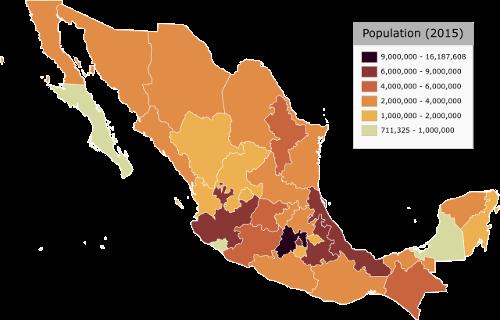 Map of Mexican states by population 2015Photo: Cookieo131 Cihuaweb CC 3.0 Unported no changes made
Map of Mexican states by population 2015Photo: Cookieo131 Cihuaweb CC 3.0 Unported no changes made
23.3% of the population is under 15 years; 68.6% is between 15 and 65 years; 8.2% of the population is over 65 years.
The Spanish conquerors and later immigrants mixed with the Indians and these people with both Spanish and Indian blood are called mestizos (mestizos). About 62% of the population consists of mestizos who mainly live in the cities. The Indians (indígenas) make up about 21% of the population. About 9% of the population is of white Spanish descent; they are called criollo. They are the most influential in the governance of the country. Approx. 1% of the population is of African or Asian descent.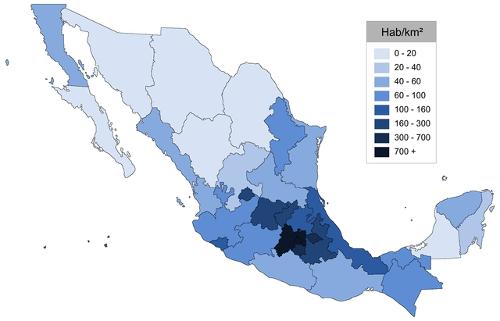 Population density MexicoPhoto: AlexR.L. CC 3.0 Unported no changes made
Population density MexicoPhoto: AlexR.L. CC 3.0 Unported no changes made
A special group are the Mennonites, descended from North German and Dutch Mennonites who emigrated to Mexico in 1922. This orthodox, traditionally living Protestant group was founded in the 16th century by the Dutchman Menno Simons. They mainly live in northwestern Mexico, including in the vicinity of Chihuahua and Cuauhtemoc. Through the use of modern farming methods they have achieved a reasonable amount of prosperity.
High unemployment and poverty in rural areas are the main causes of urban migration and strong migration to the United States. Legally, the number of Mexicans moving to the United States is about 60,000 people per year, but the number of illegal emigrations is much bigger.
Indians
The people of Native American descent live mainly in Central and Southern Mexico, in the states of México, Puebla, Veracruz, Guerrero, Oaxaca, Chiapas, Campeche, Yucatán and Quintana Roo. They live mainly in rural areas in often difficult circumstances. Health care, education, housing and the food situation are often worse than in the cities. They also hardly have their own land and therefore cannot provide for their own maintenance. They often hire themselves out as seasonal workers.
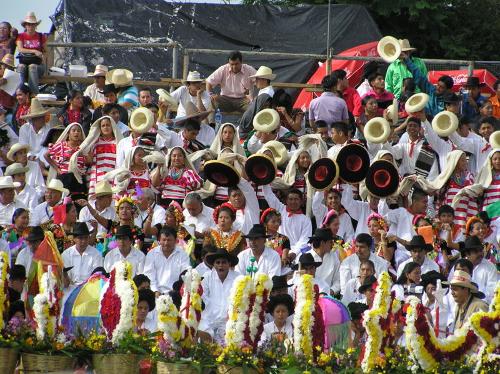 Mexico indigious peoplePhoto: Unknown CC 3.0 Unported no changes made
Mexico indigious peoplePhoto: Unknown CC 3.0 Unported no changes made
There are 59 different tribes, each speaking their own language. The largest tribes live in Central Mexico, such as the Náhuatl who descended from the Aztecs. Other tribes are the Tarascans, the Totonacs, the Mazahua and the Otomí. Southern Mexico is home to descendants of the Maya, such as the Chontal, the Tzeltal and the Tzotzil. Furthermore, Mixe, Chinanteken, Mazatec, Zapotec and Mixtec still live here.
According to official counts, there must be between three and four million full-blooded Indians living in Mexico. Most tribes have integrated Christianity into their own traditional beliefs. Christian saints are revered, as well as ancient gods.
Some details:
The long-haired Lacandones belong to the Maya and form a small group of less than 500 Indians who live together in groups of two or three families. They live in the south in the state of Chiapas, near the border with Guatemala in the tropical rainforest.
They are fishermen, hunters and farmers who, when the soil becomes exhausted, move to another area. They still worship their ancient gods, especially the important sun god and the rain god; the missionaries don't visit their homes because of the ther inhospitability.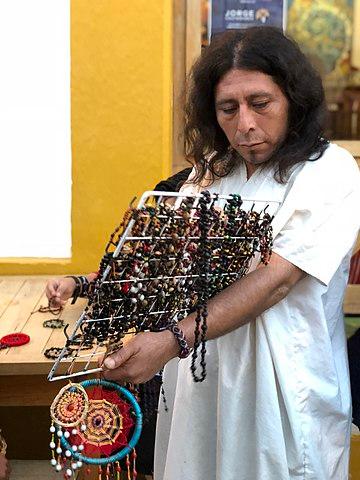 Lancandon Maya, MexicoPhoto: AlexMexicanGuide CC 4.0 International no changes made
Lancandon Maya, MexicoPhoto: AlexMexicanGuide CC 4.0 International no changes made
The Náhuas descend directly from the Aztecs and therefore still speak the Aztec language, Náhuatl. It is the largest group of Indians in Mexico with about 1 million members. They live from livestock and agriculture and mainly live in the states of Puebla, Tlaxcala, Hidalgo, Veracruz and Guerrero. They adhere to the Catholic faith but also believe in supernatural beings.
The approximately 200,000 Tzotzils and the Tzeltals descend from the Mayas and still speak a Mayan dialect. They live in several villages in the highlands of the state of Chiapas around the city of San Cristobál de las Casas. The Tzeltals live on the lower slopes, while most Tzotzils live in the same area above the 1500 meter border. It is striking that each village has its own identity, which is reflected in the color of the clothing. They too have been converted to the Catholic faith but still believe, for example, that Jesus has changed into the sun. Chulmetic, the goddess of the earth, is also still revered.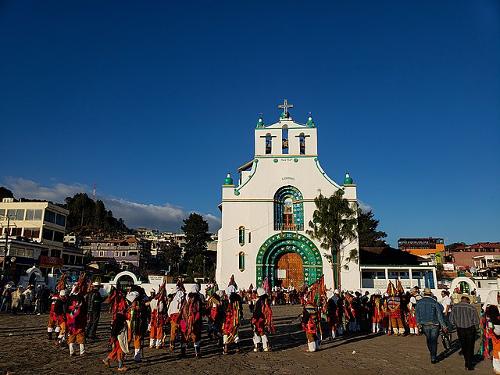 Tzotzil carnival participants doing rituals and traditional carnival dances in the San Juan Chamula temple, MexicoPhoto: Jonathan Alexis G CC 4.0 International no changes made
Tzotzil carnival participants doing rituals and traditional carnival dances in the San Juan Chamula temple, MexicoPhoto: Jonathan Alexis G CC 4.0 International no changes made
The approximately 60,000 Tarahumaras live in the state of Chihuahua, in small villages and sometimes even in cave houses scattered across the mountainous country. Due to the isolated location of the villages, they have been able to largely retain their traditional way of life. The running races in which the Tarahumaras sometimes run for hundreds of kilometers are famous. They call themselves "Raramuri", riders on foot.
The Tarahumaras have converted to the Catholic faith but still believe in a sun and moon god.
The nearly 100,000 Tarascans, who call themselves Purépecha, live on a high plateau in the state of Michoacán around Lake Pátzcuaro. They live from agriculture and fishing and are also known as craftsmen who make beautiful things from wood, they are also making pottery, especially beautiful pitchers, pans and bowls. Fishing is done with hollowed-out tree trunks and very special butterfly-shaped nets. The Tarascan village of Ocumicho specializes in making clay devils of all shapes and sizes. The Catholic faith is satureded with traditional Native American customs.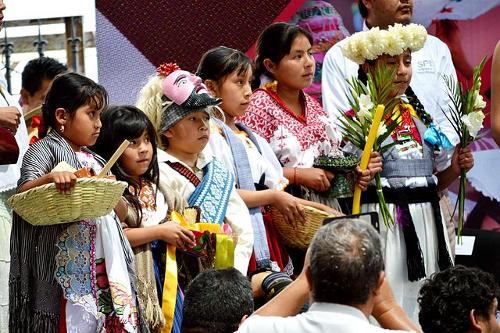 Purhepecha people MexicoPhoto: AlejandroLinaresGarcia CC 4.0 International no changes made
Purhepecha people MexicoPhoto: AlejandroLinaresGarcia CC 4.0 International no changes made
Just like the Lacandones, the Seris tribe consists of less than 500 members, making them one of the smallest Mexican Indian tribes. They live between the Gulf of Mexico and the western Sierra Madre in the state of Sonora, mainly in the village of Desemboque. They are fishermen and hunters of sea turtles, who also earn a little extra with handicrafts of reed, hardwood animal figures and shell strings. The heavy, decorative baskets made from the "torote" fiber are known. This tribe has succeeded best in preserving their own identity and their religion.
The approximately 8,000 Huichol Indians live in the western Sierra Madre of the states of Jalisco and Nayarit. They live from agriculture, livestock and handicrafts. Although converted to the Catholic faith, nature gods still play a much more important role. The Huichol are therefore considered one of the peoples of Mexico least affected by Western influences.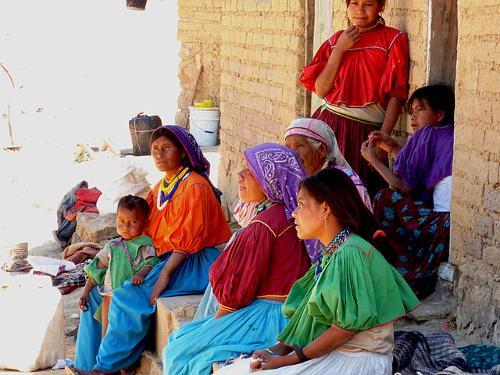 Huichol women, MexicoPhoto: Jupagame CC 3.0 Unported no changes made
Huichol women, MexicoPhoto: Jupagame CC 3.0 Unported no changes made
Very important in their religion is the peyote cactus, a thornless cactus species. The peyote buds of this cactus species provide consciousness-expanding experiences and visions. Eating peyote is also associated with ceremonies held on the occasion of sowing and harvesting. The plant is also eaten to come into direct contact with the gods. The most beautiful wool paintings are made under the influence of the hallucinatory effect of the peyote.
Every Huichol is expected to make the pilgrimage to the desert of San Luis Potosi once in his life, where the peyote cactus grows. In a centrally located round temple or "tuki", religious ceremonies are held after the tour led by a singing medicine man or "tzauririka". Deer hunting is also an important part of their way of life.
The approximately 4000 Cora Indians live in the mountains of the Sierra de Nayarit, in the state of Nayarit. They are very fond of their own culture and have many similarities with the Huichol Indians. They too know the use of the peyote and nature gods also play an important role in their religion. They cultivate small plots of land (milpa) for their own use and sell cattle and beautifully woven fabrics.
In the states of Veracruz and San Luis Potosi still live about Huasteken. They speak Spanish as well as a Mayan dialect. They have been converted to the Catholic faith, but traditional Indian ceremonies led by shamans still play an important role. They make a living from corn, beans and rice production and make hats, mats and bags.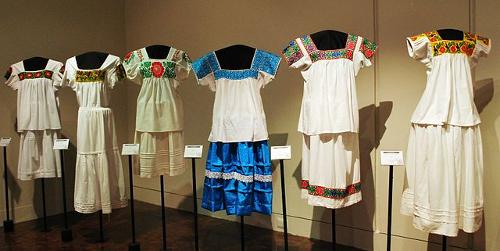 Traditional Huastec clothes, MexicoPhoto: AlejandroLinaresGarcia CC 3.0 Unported no changes made
Traditional Huastec clothes, MexicoPhoto: AlejandroLinaresGarcia CC 3.0 Unported no changes made
The approximately 150,000 Totonacs live in the tropical coastal regions of Veracruz and the highlands of the Sierra Madre of Puebla. As with many Mexican Indian peoples, the Totonacs also interprete Catholic rituals in their own way. Oil has been found in their area and among other things their traditional way of life is strongly influenced by modern western society.
The state of Oaxaca and the mountainous region of Guerrero and Puebla are home to nearly 300,000 Mixtecs who live from agriculture and livestock. They also produce "mezcal," an alcoholic drink. The Catholic faith is combined with its own traditional customs. Supernatural powers and healing shamans play an important role in their religion.
The approximately 350,000 Zapotecs also live in the state of Oaxaca, where they live from arable farming and the production of beans and honey. The Zapotec language consists of 42 different dialects.
Approx. 630,000 authentic Maya still live in the states of Quintana Roo, Campeche and Yucatán. They are mainly arable farmers and they grow a lot of tobacco and sisal. The famous Panama hat is made from sisal. Women wear beautiful embroidered white dresses and a wide shawl, the "rebozo".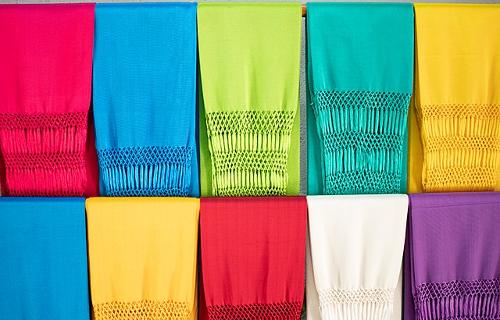 Rebozo shawls, MexicoPhoto: A01610095 CC 4.0 International no changes made
Rebozo shawls, MexicoPhoto: A01610095 CC 4.0 International no changes made
Sources
Daling, T. / Mexico : mensen, politiek, economie, cultuur, milieu
Koninklijk Instituut voor de Tropen / Novib
Dunlop, F. / Mexico
Van Reemst,
Mexico
Cambium
Rokebrand, R. / Mexico
Gottmer/Becht
Rummel, J. / Mexico
Chelsea House Publishers
Wagenvoort, E. / Reishandboek Mexico
Elmar
CIA - World Factbook
BBC - Country Profiles
Copyright: Team The World of Info